
The
Danish (and Norwegian) Church, Wellclose Square
A CHURCH FOR DANISH AND NORWEGIAN SETTLERS

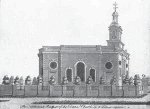
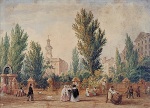 Although
now usually referred to as 'the Danish Church', Norwegians who had
settled in the area were also
involved in its foundation, worship and finance: the two kingdoms of Denmark and Norway were in a 'personal union' from 1536-1814. The timber trade
received an impetus from the rebuilding of the City after 1666: it was
said Norwegians warmed themselves
comfortably by the Fire of London. Church regulations
were drawn up in 1691, and the 1694 letters patent, granting a licence
to build a church in Marine [i.e.Wellclose] Square were issued to two
Norwegian merchants, Martin Lionfeld and Theora
Wegersloff; Lionfeld was appointed superintendent of the project and
treasurer of the funds. A 999-year lease, at £5 per year, was obtained
from Sir Michael Heneage [hence Heneage Street] and others.
Although
now usually referred to as 'the Danish Church', Norwegians who had
settled in the area were also
involved in its foundation, worship and finance: the two kingdoms of Denmark and Norway were in a 'personal union' from 1536-1814. The timber trade
received an impetus from the rebuilding of the City after 1666: it was
said Norwegians warmed themselves
comfortably by the Fire of London. Church regulations
were drawn up in 1691, and the 1694 letters patent, granting a licence
to build a church in Marine [i.e.Wellclose] Square were issued to two
Norwegian merchants, Martin Lionfeld and Theora
Wegersloff; Lionfeld was appointed superintendent of the project and
treasurer of the funds. A 999-year lease, at £5 per year, was obtained
from Sir Michael Heneage [hence Heneage Street] and others.
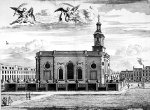 The
Danish ambassador laid the first stone in 1694. Until the church was
completed the congregation met in Old Gravel Lane, Wapping. It was
consecrated in 1696. King Christian V of Denmark [Christian Street, off
Cable Street, is named after him] contributed £2000, plus an annual sum
for its upkeep - supplemented by annual collections in Denmark and
Norway for the minister and the relief of the poor, and levies on
Danish shipments. Over
the entrance was the inscription Templem
Dano Norwegicum
intercessione et munificento serenissimi Danorum Regis Christiani
Quinti erectum - MDCXCVI.
The
Danish ambassador laid the first stone in 1694. Until the church was
completed the congregation met in Old Gravel Lane, Wapping. It was
consecrated in 1696. King Christian V of Denmark [Christian Street, off
Cable Street, is named after him] contributed £2000, plus an annual sum
for its upkeep - supplemented by annual collections in Denmark and
Norway for the minister and the relief of the poor, and levies on
Danish shipments. Over
the entrance was the inscription Templem
Dano Norwegicum
intercessione et munificento serenissimi Danorum Regis Christiani
Quinti erectum - MDCXCVI.

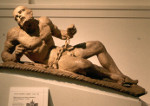
 The
original architect was Thomas Woodcock, but he was replaced by Caius
Gabriel Cibber (1630-1700 - portrait left by the Swedish miniaturist Christian Richer, and Kip's 1696 engraving based on Cibber's drawing of the church right).
He was an Italian-trained Danish
sculptor who had settled in England and found favour with William
III. His most famous, and iconic, carved sculptures are the two
life-size statutes which stood over the gateway of the Bethlem Hospital
[popularly known as Bedlam] from 1676-1815, Melancholy and Raving Madness, juxtaposing
the two extremes of mental ill-health in those days: one free of
restraint, but expressionless and unengaged, the other in furious
agony, and hospital chains. They moved with the hospital to Southwark
(now the site of the Imperial War Museum) and in 1930 to the hospital's
present site in Beckenham, once amidapple orchards but its spacious grounds now surrounded by suburbia. In 2015 its administrative block was converted into a £4m gallery and museum (replacing a cramped shed), and the sculptures now flank the stairway. Cibber also
designed the bas-reliefs on the plinth of The Monument. Cibber gave his services free; he was, said one commentator, a gentlemanlike man and
a man of good sense but died poor.
The
original architect was Thomas Woodcock, but he was replaced by Caius
Gabriel Cibber (1630-1700 - portrait left by the Swedish miniaturist Christian Richer, and Kip's 1696 engraving based on Cibber's drawing of the church right).
He was an Italian-trained Danish
sculptor who had settled in England and found favour with William
III. His most famous, and iconic, carved sculptures are the two
life-size statutes which stood over the gateway of the Bethlem Hospital
[popularly known as Bedlam] from 1676-1815, Melancholy and Raving Madness, juxtaposing
the two extremes of mental ill-health in those days: one free of
restraint, but expressionless and unengaged, the other in furious
agony, and hospital chains. They moved with the hospital to Southwark
(now the site of the Imperial War Museum) and in 1930 to the hospital's
present site in Beckenham, once amidapple orchards but its spacious grounds now surrounded by suburbia. In 2015 its administrative block was converted into a £4m gallery and museum (replacing a cramped shed), and the sculptures now flank the stairway. Cibber also
designed the bas-reliefs on the plinth of The Monument. Cibber gave his services free; he was, said one commentator, a gentlemanlike man and
a man of good sense but died poor.
Millicent Rose, in The East End of
London (Cresset Press 1951), p21, says
| He was one of the most accomplished, most European artists working in Stuart England; sculptures by his hand are part of the the fabulous riches of Chatsworth, and Wren welcomed him as collaborator, employing him to make the skyline figures for Trinity College Library, Cambridge, and also to take part in the decoration of St. Paul's and Hampton Court. The influence of Wren is obvious in the Danes' Church; the grouping of round and round-headed windows, the decorative swags of carved stone, the little campanile, all recall elements from the City churches. The most obvious affinity is with St Benet's, Paul's Wharf, a comparison which also emphasizes the difference between the two churches. St Benet's, with its small roofs, lacks the cosmopolitan unity of its eastern contemporary; it was not Wren's custom, in a building of this size, to hide the roof behind a parapet. Cibber's little church has a personality of its own, and though its creator had been in England nearly half a century, he speaks his English with a slightly foreign intonation. |

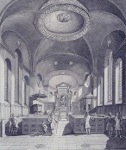 As
well as designing the church [interior, left: engraving by Kip, 1697], Cibber created external and internal
sculptures. Outside, on the west front, were bronze [some sources say lead] figures of
Faith, Hope and Charity [Charity pictured right], generally agreed to be the work of his studio, which in 1908 were moved to the Carlsberg
Ny Glyptothek,
an art museum in Copenhagen. Inside, there was an elaborately carved
pulpit; at its side was an iron and gilt box containing four hour
glasses. The reredos had four
baroque figures carved in wood: Moses, John the Baptist, St Peter and St Paul. However, Margaret Whinney, in Sculpture in Britain 1530-1830 ch.7 (2nd ed, Yale UP 1992) argues that only the first two could be his work; the other two are more in the style of Antwerp. [See below for their subsequent movements - and also for a picture of a carved boss now located in St Paul's School]. Over the altar was a
painting of the angel strengthening Christ in Gethsemane. There were two west-end
galleries.
As
well as designing the church [interior, left: engraving by Kip, 1697], Cibber created external and internal
sculptures. Outside, on the west front, were bronze [some sources say lead] figures of
Faith, Hope and Charity [Charity pictured right], generally agreed to be the work of his studio, which in 1908 were moved to the Carlsberg
Ny Glyptothek,
an art museum in Copenhagen. Inside, there was an elaborately carved
pulpit; at its side was an iron and gilt box containing four hour
glasses. The reredos had four
baroque figures carved in wood: Moses, John the Baptist, St Peter and St Paul. However, Margaret Whinney, in Sculpture in Britain 1530-1830 ch.7 (2nd ed, Yale UP 1992) argues that only the first two could be his work; the other two are more in the style of Antwerp. [See below for their subsequent movements - and also for a picture of a carved boss now located in St Paul's School]. Over the altar was a
painting of the angel strengthening Christ in Gethsemane. There were two west-end
galleries.
One commentator remarked
that
the church was a
commodious and
elegant structure, and though the architect appears to have
understood ornaments, he has not been too lavish in the use of them. Others were less complimentary: one said it was an
object of curiosity and ridicule ... a parcel of wainscot Christianity
... stinking of pitch and tar ... and seafaring apparel. See further H. Faber Caius Gabriel Cibber, 1630–1700... with a short account of the old Danish church in London
(Oxford 1926), and, for a recent assessment of the theological
significance of the buildings of this period, essays edited by Andrew
Spicer as Lutheran Churches in Early Modern Europe (Ashgate 2012).
A fine organ was installed in 1678 by 'Father' Smith (Bernard Schmidt,
c1603-1708), one of forty or fifty instruments he built, and is said to
have been played by Haydn, Blow, Purcell and Handel; its console was retained after the demolition of the church, but has since disappeared. [At the Danish Church's present home in Regent's Park is an organ of 1778 by Samuel Green which
Mendelssohn once played.]
Cibber's
second wife Jane Colley (b.1646), whom married in 1670, was probably
the first to be buried in the vault beneath the church when she died in
1697 - the list of 1869, when coffins were moved into a bricked-up area (as explained below), includes body embalmed supposed to be the wife of the Architect (C. Gabriel Cibber of Flenoborg).
He died three years later, and was buried either in the vault or the
churchyard. The earliest named coffin on the 1869 list is from 1708,
and there were no more until 1753; but In a private note of
1883 the Revd Dan Greatorex, first Vicar of St Paul's, stated that
husband and wife were both buried in the vault. There was
apparently a marble monument to Jane, but it was lost.Their son was the extrovert dandy Colley
Cibber (1671-1757), an
actor-dramatist who became Poet Laureate, and whose Apology
of 1740 is a mine of information about the theatre of this period.
He was probably buried at Grosvenor Chapel, South Audley Street, and is
memorialised in Westminster Abbey.
Other
monuments
were to Christian Wegersloff, merchant, and his three wives Letitia
(and her sister Mary Collins), Anne and Mary (1767); Anna Penelope,
relict of William Jackson and wife of Herman Pohlman, merchant (1734),
and Herman Pohlman (1754); Ambrosia, daughter of George Michelsen,
widow of Pastor Borneman and wife of John Collett (1740); John
Collett, merchant (1759) - a descendant of John Colet,
Dean of St Paul's Cathedral, who re-founded St Paul's School in 1512;
Claudius Heide, merchant (1774); Georg(e) Wolff, Danish and
Norwegian
consul (died 1828 aged 92) and his wife Elizabeth (1770) and relative
Ernst Fridrick, an elder of the church who published a book about the
church in
Copenhagen in 1802 - see more about this family here; and Peter
Alsing, the last churchwarden. There were statues of Frederic King of
Denmark, and of Charles II and William III.
In 1768 the
young King of Denmark paid an extended visit to London, travelling incognito
under the name of the Prince of Travandahl, and watched closely by the
press. He attended worship at the church one Sunday, attended by
'several of the nobility', and sat in the royal pew, enclosed by sash
windows.
According
to James Southerden Burn, The History of
the French, Walloon, Dutch and Other Foreign Protestant Refugees &c
(1846) [p241], all the church records were burned at the end of the
18th
century after 'difficulties', leaving only one register, covering the
period 1802-16. This recorded many communicants on prisoner of war
ships, including the Irresistible
and Bahama at Chatham
(1809-10), the Brave at
Plymouth (1811), the Buckingham,
Nassau, Fryen and others. Burn also gives a
list of ministers who served the church:
|
Iver Brink (1690-1702) [or Branck: his portrait hung in the vestry] Jorgen Ursin
Philip Julius Borneman FRS Soren Poulsen (1725-48, died in office) |
? Michelsen
(17??-70, died in office)
Hans Christian Roede (1771-74) Hans Hammond (1775-??) Andreas Charles Kierulff (????-1816) |
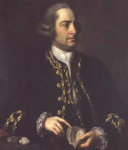 At
some stage, the church appears to have been struck by lightning.
Gustavus
Brander FRS FAS (1720-87) [right
- painting by Nathaniel Dance], a Swedish naturalist and
dilettante, reported to the Royal Society on its effects (Phil. Trans. XLIV. 298). Brander
was a curator of the British Museum and a Director of the Bank of
England;
inheriting his uncle's fortune, he spent his latter years collecting
(including the elaborate coronation chair of the German emperors) and
landscaping his Hampshire garden. He gave a significant collection of
Hampshire
fossils (with notes by Dr Solander) to
the British Museum. He also
published notes on The Form of
Cury [sic], a Roll of Ancient
English Cookery.
At
some stage, the church appears to have been struck by lightning.
Gustavus
Brander FRS FAS (1720-87) [right
- painting by Nathaniel Dance], a Swedish naturalist and
dilettante, reported to the Royal Society on its effects (Phil. Trans. XLIV. 298). Brander
was a curator of the British Museum and a Director of the Bank of
England;
inheriting his uncle's fortune, he spent his latter years collecting
(including the elaborate coronation chair of the German emperors) and
landscaping his Hampshire garden. He gave a significant collection of
Hampshire
fossils (with notes by Dr Solander) to
the British Museum. He also
published notes on The Form of
Cury [sic], a Roll of Ancient
English Cookery. 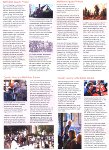
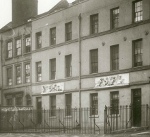
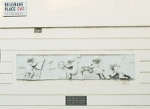 The Danish-Norwegian
Consulate was at 20 & 21 Wellclose Square on the west side from at least 1787, from the time when Georg Wolff lived there and held the post [left in the 1930s]. When the building was demolished in 1968 the 1796 Coade stone reliefs depicting the arts and sciences were moved to the Norwegian
Embassy in Belgrave Place, Belgravia (the Danish Embassy is in Sloane Street); Shapla School now stands on its site. Right are pages from the June and November editions of the Anglo-Danish Society's News and Reviews about
a much-enjoyed 2012 visit to the area, which we hope will
lead to continued contact, and the marking of the historic Danish
presence in some tangible way.
The Danish-Norwegian
Consulate was at 20 & 21 Wellclose Square on the west side from at least 1787, from the time when Georg Wolff lived there and held the post [left in the 1930s]. When the building was demolished in 1968 the 1796 Coade stone reliefs depicting the arts and sciences were moved to the Norwegian
Embassy in Belgrave Place, Belgravia (the Danish Embassy is in Sloane Street); Shapla School now stands on its site. Right are pages from the June and November editions of the Anglo-Danish Society's News and Reviews about
a much-enjoyed 2012 visit to the area, which we hope will
lead to continued contact, and the marking of the historic Danish
presence in some tangible way. 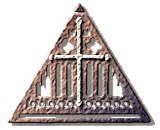 The congregation
is now part of the Danske Sømands og Udlands Kirker
(DSUK) - The Danish Church Abroad / Danish Seamen's Church - founded in
2004 through the merger of The Danish Church Abroad and The Danish
Seamen's Church in Foreign Harbours. The DSUK is affiliated to the Evangelical Lutheran Church of Denmark, which on 3 October 2010 became a full member of the Porvoo Agreement
(to which they were committed from the outset, but had constitutional
difficulties about how they could sign up), so - like the Swedes, Finns
and other Baltic and Nordic churches in London - are in communion with
the Church of England. See further Den Danske Kirke i London 1692-1992 (with English resumé by Inga Henriksen Taylor).
The congregation
is now part of the Danske Sømands og Udlands Kirker
(DSUK) - The Danish Church Abroad / Danish Seamen's Church - founded in
2004 through the merger of The Danish Church Abroad and The Danish
Seamen's Church in Foreign Harbours. The DSUK is affiliated to the Evangelical Lutheran Church of Denmark, which on 3 October 2010 became a full member of the Porvoo Agreement
(to which they were committed from the outset, but had constitutional
difficulties about how they could sign up), so - like the Swedes, Finns
and other Baltic and Nordic churches in London - are in communion with
the Church of England. See further Den Danske Kirke i London 1692-1992 (with English resumé by Inga Henriksen Taylor).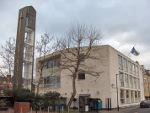
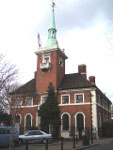
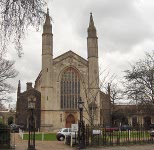 Here [left to right] are
pictures of the Danish Church in Regent's Park mentioned above - and see also this video; of St
Olav's, the Norwegian Church in Rotherhithe (by the entrance to the
Rotherhithe tunnel), which forms part of Sjømannskirken, the Norwegian Church Abroad; and also, for the sake of completeness, of the nearby Finnish Church
in Albion Street (also part of the Porvoo 'family'). Although there was
never a Finnish Church north of the river, the Rector of St
George-in-the-East has Finnish connections, and we often host visits
from friends and officers of the Evangelical Lutheran Church of Finland.
Here [left to right] are
pictures of the Danish Church in Regent's Park mentioned above - and see also this video; of St
Olav's, the Norwegian Church in Rotherhithe (by the entrance to the
Rotherhithe tunnel), which forms part of Sjømannskirken, the Norwegian Church Abroad; and also, for the sake of completeness, of the nearby Finnish Church
in Albion Street (also part of the Porvoo 'family'). Although there was
never a Finnish Church north of the river, the Rector of St
George-in-the-East has Finnish connections, and we often host visits
from friends and officers of the Evangelical Lutheran Church of Finland.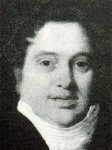 As
the Danish community in the area declined - tending to move first to
Mile End Old Town and then to Essex - and the church was abandoned, it passed into the hands of a non-denominational seafarers' mission and became a base for the Bethel Flag Union
and the temperance cause. It was taken on an annual lease in 1824 by George Charles ('Bo'sun') Smith,
a Baptist [right]. There is a page about him and his many organisations for seafarers and their families here, with extracts from his writings, and more detail in Roald Kverndal's Seamen's Missions: Their Origin and Early
Growth (1986). His vision for the area he dubbed 'Satan's Sailortown Seat' was
As
the Danish community in the area declined - tending to move first to
Mile End Old Town and then to Essex - and the church was abandoned, it passed into the hands of a non-denominational seafarers' mission and became a base for the Bethel Flag Union
and the temperance cause. It was taken on an annual lease in 1824 by George Charles ('Bo'sun') Smith,
a Baptist [right]. There is a page about him and his many organisations for seafarers and their families here, with extracts from his writings, and more detail in Roald Kverndal's Seamen's Missions: Their Origin and Early
Growth (1986). His vision for the area he dubbed 'Satan's Sailortown Seat' was
| The Headquarters would be the great rendezvous of the lost and guilty, where the officers of the Captain of Salvation may, under his orders, invite, persuade and impress those poor wretched wanderers who pass by, and graciously compel them to enter the receiving ship of his church universal, from whence they may be drafted to the several cruisers in the glorious service of his Celestial Majesty and in which, according to telegraphic orders, they may war a good warfare against the Lord's enemies and theirs. |
In
1827 this use of the church provoked 'E.I.C.' to write to the Gentleman's
Magazine in these terms:
In
1859 a scheme was made in Chancery, approved by the Master of the
Rolls, for the administration of the Danish Chapel charity;
Anders Westerholz and Johannes Gondsund, City merchants, were appointed
trustees. The former continued to deal with the church authorities for
at least 25 years. In 1874, on paper embossed 'Consulate General of
Denmark', he acknowledged a gift from the parish of £75 towards the new
Danish church.
For
the final, and very different, stage in this building's history, see
St Saviour & St Cross Chapel. (In 1859 Bo'sun Smith, then aged 77, was ejected from the chapel for protesting against Popery in a protestant church.) When
the Rector Bryan King tried to have a district assigned to this
church for the Mission, the minister of St Paul Dock Street,
Dan
Greatorex (who was a firm Protestant), objected, and stirred up other
local clergy, including Thomas Richardson
at St Matthew Pell Street,
to
protest about the spread of 'Puseyism' in Stepney. The Bishop
settled the dispute by having a district assigned to St Paul's in
1864. (It had not previously had parish boundaries because it was the
'Church for Seamen of the Port of London'). Since the Mission fell into
this district, Greatorex closed it,
and bought the building for £2,000, intending to
convert it into a school - the 999-year leases were assigned to the
Vicar and chapel-wardens 'upon trust for schools' in 1868/9, with
covenants about coffins and remains, and permission to remove tablets,
pictures and carved figures. So all the
Mission's activities transferred
to Wapping.
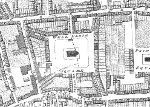 In
the event, when Greatorex' architect brother
Reuben surveyed the building, he found the walls to be out of true, the south
wall by 7½" and the north wall by 9". Rhode
Hawkins' second opinion concurred, so it was demolished in 1869, and the school built on the same site - compare the maps [right] of 1799 and 1894.
In
the event, when Greatorex' architect brother
Reuben surveyed the building, he found the walls to be out of true, the south
wall by 7½" and the north wall by 9". Rhode
Hawkins' second opinion concurred, so it was demolished in 1869, and the school built on the same site - compare the maps [right] of 1799 and 1894. A new
school, designed by Reuben, was built on the site in 1870 and opened by
the Prince of Wales. Its story is
recorded in St
Paul's School 1870-1995 (produced
by The Sunday Times), on this page and
on the school website.
A new
school, designed by Reuben, was built on the site in 1870 and opened by
the Prince of Wales. Its story is
recorded in St
Paul's School 1870-1995 (produced
by The Sunday Times), on this page and
on the school website. |
VAULTS UNDER THE DANISH CHURCH,
WELLCLOSE SQUARE. Underneath the church there are several vaults, in which there had been deposited 37 coffins, of which 35 were of lead and 2 of wood. The walls of these vaults are four bricks, or 3 feet in thickness, and the roof is arched in brick-work of 4 rings in thickness. On inspection, I was unable to detect any offensive smell in these vaults, and I found the lead coffins to be in a sound condition. The two wooden coffins had perished, but the bodies were perfectly dry. All the coffins are now covered with earth, of 2 feet in thickness, and above this thick layer of earth there is deposited charcoal, to the extent of 1 ft. 4 inches in depth,and the vaults are bricked up, so that it is impossible that any danger to health can arise from emanations from the dead bodies in the vaults. |
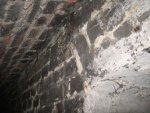
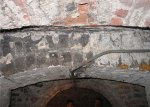
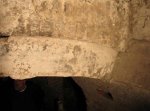


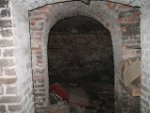
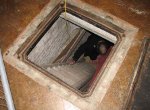
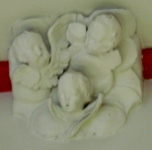 A link with the past: fixed to the eaves of a classroom at St Paul's School is this small carved boss
of a group of cherubs (now painted over), which it is believed came from Cibber's church.
A link with the past: fixed to the eaves of a classroom at St Paul's School is this small carved boss
of a group of cherubs (now painted over), which it is believed came from Cibber's church.For more on Wellclose Square, see here; and for a 1934 account of some of its
inhabitants, see here. For an article by an English correspondent
of the Danish national press, who covers church affairs, and lived in this parish until recently,
click here
(if you read Danish!)
See here
for a recent brief visit by three children from St Paul's School to
Oslo, to see the Trafalgar Square Christmas tree being felled.
Homepage | About Us | Services & Events
| Church &
Churchyard |
History
Newsletters & Sermons | Contacts,
Links & Registers | Giving | Picture
Gallery |
Site Map